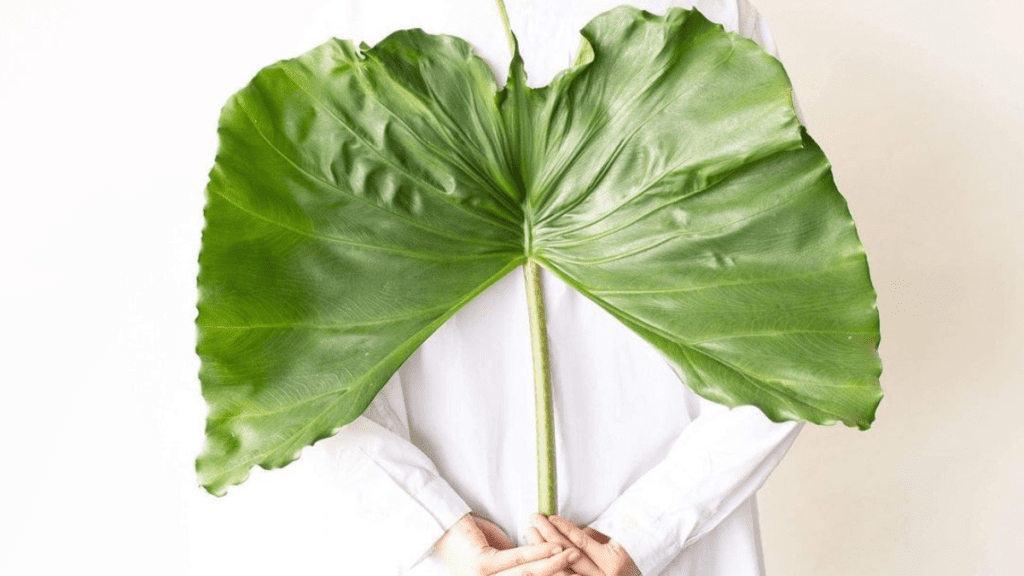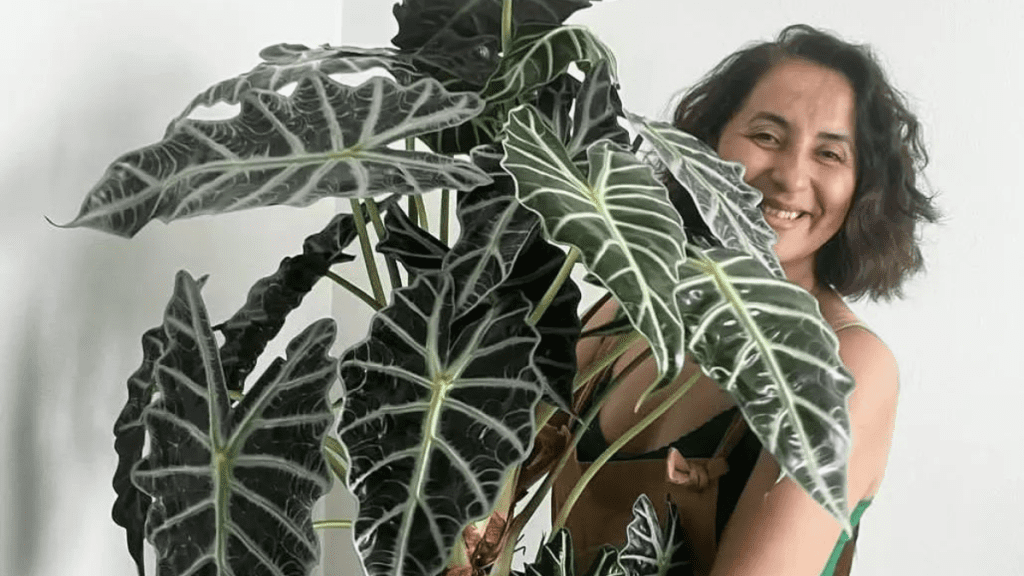Welcome, plant parents! Meet the captivating Alocasia Hilo Beauty—a tropical wonder boasting stunning coloration and intricate leaf structure.
Originating from Southeast Asia, this plant not only adds elegance to your space but also purifies the air, making it a must-have for any indoor garden.


Getting to Know Alocasia Hilo Beauty
Let’s take a closer look at what makes the Alocasia Hilo Beauty such a standout in the world of houseplants. With its arrow-shaped leaves and striking coloration, this tropical beauty commands attention wherever it’s placed. Native to Southeast Asia, it thrives in warm, humid environments, making it an ideal addition to your indoor oasis.
One of the most fascinating aspects of the Alocasia Hilo Beauty is its ability to adapt to various light conditions. While it prefers bright, indirect light, it can tolerate lower light levels, making it versatile for different spaces in your home. Its unique leaf structure not only adds visual interest but also plays a role in its air-purifying abilities, helping to freshen up the air in your living space.
Alocasia Hilo Beauty Care Essentials


Ensuring the well-being of your Alocasia Hilo Beauty requires attention to several key essentials:
Lighting
Alocasia Hilo Beauty thrives in environments blessed with bright, indirect light—a reflection of the gentle sunlight found beneath the verdant canopies of its native Southeast Asian habitat. Position your plant near a north or east-facing window to receive filtered sunlight throughout the day, safeguarding it from the potentially harmful effects of direct sun rays that could scorch its delicate leaves.
Care Tip: Rotate your plant periodically to ensure all sides receive adequate light exposure, fostering balanced growth and luscious foliage.
Watering
Maintaining a delicate equilibrium between moisture and drainage is paramount for the well-being of your Alocasia Hilo Beauty. Water your plant when the top inch of soil feels dry to the touch, ensuring a thorough watering session until water trickles from the drainage holes at the bottom of the pot. Avoid succumbing to the temptation of overwatering, as it could spell disaster by predisposing your plant to dreaded root rot.
Care Tip: Opt for room temperature water to shield your plant’s sensitive roots from shock, and consider employing a saucer or tray beneath the pot to capture excess water, thwarting the perils of waterlogging.
Humidity
Having evolved in tropical climes, Alocasia Hilo Beauty flourishes in environments boasting high humidity levels. To replicate its native habitat, endeavor to bestow upon your plant copious amounts of humidity, particularly during the dry winter months or within abodes heated by central heating systems. Augment humidity levels by misting your plant regularly, situating it in close proximity to a humidifier, or fashioning a pebble tray replete with water beneath its pot.
Care Tip: Foster a sense of camaraderie among your plant collection by grouping your Alocasia Hilo Beauty with other moisture-loving plants, creating a microclimate conducive to elevated humidity levels.
Temperature
The ideal temperature range for your Alocasia Hilo Beauty mirrors the balmy conditions of its native tropics. Aim to maintain temperatures between 65°F to 80°F (18°C to 27°C), steering clear of the frigid realms below 60°F (15°C) which could inflict harm upon its delicate foliage. Furthermore, shield your plant from drafts and abrupt temperature fluctuations, as they have the potential to induce stress and pave the way for a litany of maladies.
Care Tip: As the mercury plummets during the chillier months, afford your plant respite from icy drafts by relocating it away from windows and doors, safeguarding its well-being.
Soil
Crafting an optimal soil mix lays the groundwork for the thriving prosperity of your Alocasia Hilo Beauty. Opt for a meticulously curated blend comprising well-draining, moisture-retentive components that mirror the fertile soils of its native habitat. A concoction of potting soil, perlite, and peat moss strikes a harmonious balance between drainage and moisture retention, steering clear of compacted or dense soils that could engender waterlogged roots.
Care Tip: Every couple of years, afford your Alocasia Hilo Beauty the gift of rejuvenation by repotting it, refreshing the soil and affording its roots ample space for unfettered growth and development.
Fertilization
Nourishing your Alocasia Hilo Beauty with the requisite nutrients is pivotal to nurturing its burgeoning vitality. During the bountiful growing season stretching from spring to early fall, regularly fertilize your plant with a meticulously diluted, water-soluble fertilizer boasting a balanced formulation. Exercise restraint to avert the perils of over-fertilization, which could culminate in the accretion of salts within the soil, imperiling the health of your plant’s precious roots.
Care Tip: Keep a watchful eye on your plant’s growth trajectory, recalibrating your fertilization regimen accordingly and tempering your zeal during the dormant winter months to foster a harmonious relationship with your verdant companion.
Propagation Techniques

Embark on the exciting journey of propagating your Alocasia Hilo Beauty, unlocking the potential to expand your verdant collection or share the joy of plant parenthood with fellow enthusiasts. Here are the various propagation techniques available for this captivating tropical gem.
Division
Steps:
- Prepare the Plant: Carefully remove the Alocasia Hilo Beauty from its pot, gently shaking off excess soil to expose the rhizomes.
- Inspect the Rhizomes: Examine the rhizomes to identify suitable sections for division, ensuring each division possesses healthy roots and foliage.
- Divide the Plant: Using a sharp, sterilized knife, carefully cut the rhizomes into sections, ensuring that each section has at least one healthy growth point.
- Plant the Divisions: Place each division in an individual pot filled with a well-draining potting mix, ensuring the rhizome is covered and the foliage is exposed.
- Provide Optimal Conditions: Keep the newly potted divisions in a warm, humid environment with indirect light, watering regularly to maintain soil moisture.
Advantages:
Allows for the creation of multiple plants from a single specimen.
Established divisions tend to grow more quickly than other propagation methods.
Disadvantages:
Requires careful handling to avoid damaging the plant’s delicate roots and rhizomes.
May not be suitable for plants with limited root systems or those that are not actively growing.
Care Tip: When dividing your Alocasia Hilo Beauty, ensure each division has sufficient roots and foliage to support its growth.
Offsets
Steps:
- Identify Offsets: Locate the offsets or baby plants growing from the parent rhizome of your Alocasia Hilo Beauty.
- Gently Detach Offsets: Using your fingers or a small knife, carefully detach the offsets from the parent rhizome, taking care not to damage the roots.
- Prepare Pots: Fill small pots with a well-draining potting mix, ensuring there are drainage holes at the bottom.
- Plant the Offsets: Place each offset in its own pot, burying the roots in the soil and ensuring the foliage is above the surface.
- Maintain Moisture: Water the newly potted offsets thoroughly and keep the soil consistently moist to encourage root development.
Advantages:
Offsets are readily available on mature plants, requiring minimal effort to propagate.
Established offsets often grow quickly and reliably.
Disadvantages:
Not all plants produce offsets, limiting this propagation method to certain species or cultivars.
Offsets may take time to develop roots and establish themselves as independent plants.
Care Tip: Encourage offset production by providing optimal growing conditions, including warmth, humidity, and indirect light.
Rhizome Cuttings
Steps:
- Select Healthy Rhizomes: Choose a healthy rhizome from your Alocasia Hilo Beauty, ensuring it has multiple growth points.
- Prepare Cuttings: Use a sharp, sterilized knife to cut the rhizome into sections, making sure each section has at least one growth point.
- Plant the Cuttings: Place the rhizome cuttings in small pots filled with a well-draining potting mix, burying them partially in the soil.
- Provide Adequate Care: Keep the soil consistently moist and provide warmth and indirect light to encourage root growth.
- Monitor Progress: Check the cuttings regularly for signs of growth, adjusting care as needed to support their development.
Advantages:
Allows for propagation from mature plants with established root systems.
Provides an alternative method for propagating plants that do not produce offsets.
Disadvantages:
Rhizome cuttings may take longer to establish roots and begin growing compared to other propagation methods.
Requires careful handling and attention to ensure successful rooting and growth.
Care Tip: Ensure each rhizome cutting has a viable growth point to maximize its chances of successful propagation.
Common Pests and Problems


Despite our best efforts, Alocasia Hilo Beauty may encounter various pests and problems that threaten its health and vitality. Here are the common issues you may encounter and how to address them effectively.
Pests
Aphids: These tiny insects can cluster on the undersides of leaves, sucking sap and causing leaf distortion and yellowing. To combat aphids, gently wipe affected leaves with a damp cloth or treat with insecticidal soap.
Spider Mites: Spider mites are notorious for creating fine webbing on leaves and causing stippling or yellowing. Increase humidity to discourage spider mites and use insecticidal soap or neem oil to control infestations.
Mealybugs: Mealybugs are small, white, cottony insects that feed on plant sap, causing stunted growth and leaf yellowing. Remove them manually with a cotton swab dipped in rubbing alcohol or use insecticidal soap.
Diseases
Root Rot: Overwatering or poorly draining soil can lead to root rot, characterized by mushy, brown roots and wilting foliage. To prevent root rot, ensure proper drainage and avoid overwatering. If root rot occurs, trim affected roots and repot the plant in fresh, well-draining soil.
Leaf Spot: Leaf spot is a fungal disease characterized by dark spots or lesions on leaves, often accompanied by yellowing or browning. Remove affected leaves promptly and ensure good air circulation to prevent further spread of the disease. Avoid overhead watering to minimize fungal growth.
Bacterial Leaf Blight: Bacterial leaf blight causes water-soaked lesions on leaves, which may eventually turn brown and die. Remove affected leaves and ensure proper air circulation to prevent the spread of the bacteria. Avoid overhead watering and prune overcrowded foliage to reduce humidity levels.
Care Tip: Regularly inspect your Alocasia Hilo Beauty for signs of pests or diseases, especially during periods of stress such as changes in environment or season. Early detection and prompt treatment are key to maintaining the health and vigor of your plant.
Tips for Displaying Alocasia Hilo Beauty

Elevate the visual appeal of your indoor space by showcasing your Alocasia Hilo Beauty in a manner that highlights its natural beauty and complements your decor.
Choose the Right Location
Select a location with bright, indirect light to showcase your Alocasia Hilo Beauty’s vibrant foliage. Avoid placing it in direct sunlight, as this can cause leaf burn. Consider placing your plant near a north or east-facing window where it can receive gentle sunlight throughout the day.
Opt for Decorative Containers
Enhance the aesthetic appeal of your Alocasia Hilo Beauty by planting it in decorative containers that complement your home decor. Choose pots with drainage holes to ensure proper moisture management and consider incorporating different textures and materials such as ceramic, terracotta, or woven baskets to add visual interest.
Group with Complementary Plants
Create visually appealing displays by grouping your Alocasia Hilo Beauty with complementary plants that share similar care requirements. Consider pairing it with other tropical foliage plants or contrasting it with plants of varying heights and textures to create dynamic compositions that add depth and dimension to your indoor garden.
Rotate Periodically
Encourage balanced growth and ensure all sides of your Alocasia Hilo Beauty receive adequate light exposure by rotating it periodically. Aim to rotate your plant every few weeks to promote even growth and prevent it from leaning towards the light source.
Maintain Cleanliness
Keep your Alocasia Hilo Beauty’s foliage clean and free from dust by gently wiping the leaves with a damp cloth or spraying them with water. Regular cleaning not only enhances the plant’s appearance but also promotes optimal photosynthesis and air circulation, reducing the risk of pests and diseases.
Care Tip: Monitor your Alocasia Hilo Beauty’s growth and adjust its display location as needed to ensure it continues to thrive. Pay attention to changes in light levels and environmental conditions, and be prepared to move your plant to a more suitable location if necessary.
If you’re thinking of extending your alocasia family, I recommend reading up on alocasia azlanii and alocasia pink dragon. They would both make great additions to your squad!
Conclusion
Congratulations, plant parent, on delving into the enchanting world of Alocasia Hilo Beauty care! By providing optimal growing conditions and attentive care, you can foster the health and vitality of your plant, celebrating its beauty as it thrives in your home. Embrace the joys of plant parenthood, share your successes with fellow enthusiasts, and continue to nurture your Alocasia Hilo Beauty with love and dedication.
FAQs
How often should I fertilize my Alocasia Hilo Beauty?
Fertilize your Alocasia Hilo Beauty every 4-6 weeks during the growing season, using a balanced, water-soluble fertilizer diluted to half strength. Avoid over-fertilizing, as it can lead to salt buildup in the soil and damage the plant’s roots.
Can I place my Alocasia Hilo Beauty outdoors?
While Alocasia Hilo Beauty thrives in warm, humid environments, it is best suited to indoor cultivation in most regions. If you choose to place your plant outdoors during the warmer months, ensure it is protected from direct sunlight and strong winds, and bring it indoors before temperatures drop below 60°F (15°C).
How do I increase humidity for my Alocasia Hilo Beauty?
To increase humidity for your Alocasia Hilo Beauty, consider misting the plant regularly with water, placing a humidifier nearby, or creating a pebble tray filled with water beneath the pot. Grouping your plant with other moisture-loving plants can also create a microclimate of higher humidity.
Why are the leaves of my Alocasia Hilo Beauty turning yellow?
Yellowing leaves on your Alocasia Hilo Beauty can indicate various issues, including overwatering, underwatering, or inadequate light. Ensure you’re providing the plant with the right amount of water, proper drainage, and bright, indirect light to promote healthy foliage growth. If yellowing persists, check for pests or diseases and adjust your care routine accordingly.

Writer/Green Thumb/Explorer – Rooted deep in the rich soils of Devon, I’ve cultivated a vast expertise in plant care, helping greenery thrive in homes across the UK. When I’m not crafting detailed plant care guides, I’m journeying through the lush landscapes of the West Country, unearthing nature’s secrets and sharing them with fellow plant enthusiasts. Every leaf has a story, and I’m here to tell it.





